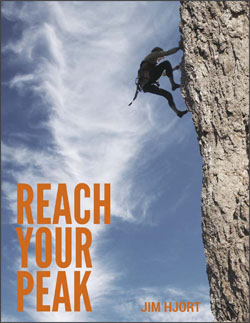Using Your Setbacks as Building Blocks: An Olympic Case Study
/One of the more dramatic moments of the 2014 Winter Olympics happened during women’s moguls skiing. The final round turned into a battle between the 2010 gold medalist, 27-year old American Hannah Kearney, and a field of five others including Canadian sisters Justine and Chloe Dufour-Lapointe.
Kearney’s dreams of becoming the first freestyle skier to win consecutive gold medals ended when she landed a jump off-balance. She didn’t fall, but the mistake cost her important style points (moguls is judged on style as well as time). She ended up with bronze and the sisters took gold and silver. (Unfortunately, I can’t provide the video, so you had to be there.)
Over the next 24 hours, television interviews with Kearney provided a time-lapse opportunity to witness someone assimilating the truth of a major negative life event.
While Olympic medals aren’t on the line for most of us, everyone has the experience of falling short sometimes, integrating that experience with the rest of their life story and identity (with varying degrees of success), and moving on with life.
The integration and narrative reconstruction process has a major bearing on how you feel about yourself and what direction you take next. So, let’s take a look at Kearney’s situation and see what we can learn.
The contamination sequence
Immediately following her run, Hannah was approached by an interviewer. She winced when the interviewer uttered the words “bronze medal” and, through tears, she said:
“When you’ve won gold, there’s always the thought that I could go and get another one. But now the peak of my athletic career is in the past, and that’s a hard thing to handle.”
Kearney was the subject of some derisive online commentary, with some calling her a crybaby. (That she was making mountains out of mogul hills, as it were.) She had won bronze, after all.
But in the realm of narrative psychology, she was experiencing what is called a “contamination sequence,” which is when things are going beautifully and then, suddenly, all is lost. And she felt the way she felt.
As a defending gold medalist and the favorite in her event, Kearney carried a load of expectations into the Olympics, both from others and herself. She’d had four years to settle into the identity of Gold Medalist—being the best in the world at something, which other Olympic athletes have described as addictive.
Kearney faced the prospect of not only validating her existing identity by taking another gold, but achieving even more renown by being the first to do so.
Embracing your victories and the identity of Champion (however those may look in your own life), and then setting your sights on an even larger long-term goal is what enables high degrees of success.
Believing in yourself and acknowledging your strengths help you to have the self-confidence you need to perform at your best, and having your eyes on a larger prize can help you maintain motivation during the inevitable difficult times.
But pinning your dreams to all-or-nothing goals that far in the future poses problems when you aren’t successful, because today's failure has the potential to severely disrupt your life narrative and impact your self-esteem retroactively to the last checkpoint.
In Kearney’s case, that meant that she not only lost the gold medal, but that she had peaked four years ago, calling into question the identity she’d held every day since then. At the top of the moguls hill she was the defending gold medalist, favored to win a second, and by the time she’d reached the bottom she’d felt transformed into a washed-up athlete four years past her prime.
What you can apply
It’s great to have long-term goals, but also make sure you have complementary short- and medium-term goals, too, and assess your progress toward all of them often. This will enable you to adjust the amount and direction of your efforts in real time, and it will also limit the downside if you encounter disappointment.
It’s similar to what rock climbers do: they clip their rope into a new anchor in the rock every so often as they climb. That way, they don’t have as far to fall if they slip.
Ambivalence: Scrambling to make sense of it
In a press conference shortly after the moguls event, Kearney was clearly still in the process of wrapping her head around what had happened, and she was still crying. Here’s what she said:
“I would like very much to ski again. I think instead I will try my absolute best to let it go. I think that will help my happiness levels going forward. You can’t live in the past, and this moment is now already over.”
One thing we see here is ambivalence: her desire to continue to find happiness in a sport she loves, versus the desire to never experience pain and disappointment of this magnitude again, by hanging up her skis.
But ambivalence isn't as confounding as it may seem. As diametrically opposed as your desires may seem superficially, they are usually just the manifestation of internal desires that are much more congruent: to feel better on one hand, and to avoid feeling bad on the other.
Kearney was wrestling with the “ski again/never ski again” dialectic as a means of addressing the underlying concern of her happiness.
Kearney is also processing the situation out loud here, and in a somewhat nonlinear way. Note that her last sentence isn't the logical conclusion of the first three. Instead, she’s telling herself what she needs to hear: that she needs to accept what has happened and plan a course for the future.
In four sentences she has acknowledged the four basic ingredients essential to reconstructing her narrative identity and moving forward: both sides of her ambivalence, her ultimate goal of being happy, and the need to reconcile all of them.
What you can apply
Ambivalence is a perfectly natural state that we all face at times. When something goes wrong, you don’t need to have everything figured out right away. Integrating a new life event into an existing narrative isn’t easy, and it only gets harder as the events get bigger and the existing narrative is more seasoned.
Allow yourself time to process what’s coming up for you: talk out all sides of the issue with someone, or write it out. Let go of the need to find a solution, and just see what emerges when you are open and honest with yourself.
Integration and the way forward
Twenty-four hours after her event, Kearney was interviewed by an ESPN correspondent, and something remarkable had happened. Here’s what she had to say:
“Although my athletic career is closer to the end than the beginning, there’s still, I hope, some bright spots in my athletic future and also in my life.”
Bravo! Here we have a perfect-10 example of acknowledging negative or self-defeating thoughts, considering what is true and untrue about them, and arriving at a new understanding that honors the divergent parts of yourself: the disappointed and the hopeful, the sad and the optimistic.
But wait, there’s more. The interviewer went on to ask Hannah what she would remember most about her career. Here was her answer:
“I’m not quite ready to retire . . . so, until I’m absolutely sure that I’m done skiing, I’m going to try not to reflect too much, because it’s easy to live in the past and when I do that I think, ‘Oh no, the best years are behind me.’ And that’s a depressing thought. So, instead I’ll try to continue to improve my skiing until I can’t any longer.”
Wow. Hannah Kearney came quite a distance in 24 hours—an Olympic-class feat in its own right. While calendar-wise her career might be nearer the nearer to the end than the beginning, she may still have the ability to improve, and intends to find out.
She has acknowledged and accepted the past, but chooses to keep an open mind about the present. Perhaps she hasn't peaked yet after all, but just had a bad day.
But her former narrative identities weren’t misguided; they were appropriate given the information she had at those times, and they served a purpose.
The first (World Beater) helped her to remain motivated and focused on her goals, while the crisis initiated by the second (Past My Prime?) brought to the surface some bits of reality that she needed to face. Namely, that her athletic career has an expiration date.
Now she has arrived at a new identity that can sustain her through the next chapter of her life, in which her bronze medal is just another data point, not the end of the line. She’ll continue to try to improve as an athlete, and perhaps embracing her fallibility will inspire her in unforeseen ways.
This is what crafting a redemptive life narrative looks like. It happens when you find meaning and value in your setbacks, and rebound to a higher level of functioning, with a more complete understanding of yourself.
In the largest sense, Kearney doesn’t need to win another gold medal to redeem herself now—she has elevated her game to a level that transcends medals and ribbons, where optimal functioning as a complete human, not just an athlete, is what's at stake. Her loss of a gold medal may well have enabled personal growth that she will ultimately find priceless.
What you can apply
Life is a lot like moguls skiing, actually, and not just because it involves a lot of bumps. It’s because, as with moguls, there are objective and subjective elements that contribute to overall success and satisfaction.
Life events themselves are non-negotiable: when they happen, they happen. Where the artistry comes into play is how flexible and creative you can be in including them in your storyline.
If you can check in frequently with how you’re doing with your objectives, have the courage to acknowledge and explore the thoughts and feelings that arise as you pursue them, and hold your life story firmly but not tightly, you’ll be prepared to keep your feet under you no matter what bumps you hit.
















